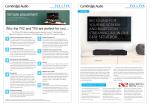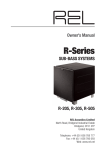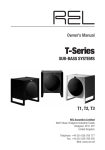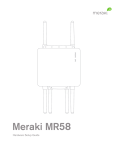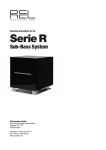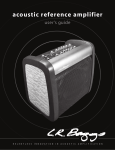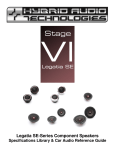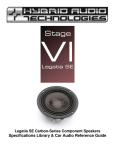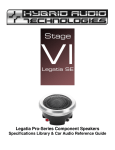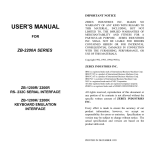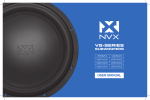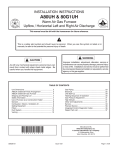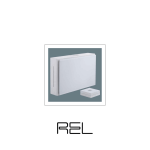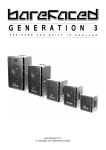Download User Manual - Music Direct
Transcript
Operating Instructions for the G1 Sub-Bass System REL Acoustics Limited North Road, Bridgend industrial Estate Bridgend, CF31 3TP United Kingdom Telephone: +44 (0)1 656 768 777 Fax: +44 (0) 1 656 766 093 Web: www.REL.net Important Safeguards 1 Read all of these instructions. 2 Save these instructions for future use. 3 Unplug from the wall socket before cleaning. Do not use liquid cleaners or aerosol cleaners. Use a damp cloth for cleaning. 4 Do not use near water. 5 Do not place on a stand or table; it may fall causing injury to a child or adult, and damage to the unit. 6 The unit should only be operated from the power source indicated on the panel of the amplifier. 7 Only use the power cord supplied. 8 Do not allow anything to rest on the power cord. Position the power cord such that it can not be walked on. 9 For added protection during a lightening storm, or when not in use for long periods of time, unplug it from the wall socket. 10 Never spill any kind of liquid on the unit. 11 Do not attempt to service the unit yourself, as removing the amplifier may expose you to dangerous voltages. Refer all servicing to your dealer. 12 Unplug the unit from the wall socket and refer servicing to your dealer under the following conditions: a b c d e When the power cord or plug is damaged. If liquid has been spilled onto the unit. If the unit does not operate properly by following the operating instructions. If the unit has been dropped and damaged. When the unit exhibits a drastic change in performance. Warning This item is heavy. To avoid risk of injury, take care when handling. Welcome Thank you for buying a REL G1 Sub-Bass System. The G1 is carefully hand-built using the finest materials available and is designed for maximum performance. This manual contains important safety information as well as helpful advice and should be carefully studied before connecting the unit. Service After Warranty All service must be arranged through an authorized REL dealer. Should the unit need to be returned for any reason, all carriage costs will be payable by the customer. Losses or damage caused during transit are the customer’s risk. Design Safety This apparatus is supplied with a detachable mains plug. For North American operation a 10 A (for UK and all 220V operation, 5 A) fuse is fitted in the plug. Should the fuse need to be replaced use a similar rated fuse approved to ASTA or BSI 362. Do not use without the fuse cover in place. Replacement fuse covers are available from your distributor. 1 About the G1 Sub-Bass System Many or most loudspeakers emphasize the mid-bass. This is the range from 50 to 90 Hz. We at REL believe this is an incomplete approach and that loudspeakers need to be supplemented in the lower frequencies for true full range reproduction. All of our designs are true Sub-Bass Systems, meaning they are designed to reproduce very low frequencies (below 30 Hz) that are felt rather than heard. This is because we believe that music is full-range, as are sound effects on movies, and we intend for our products to reproduce all of these sounds, not just a narrow band. The G-Series is equipped to allow you to take full advantage of AC3, Dolby Digital, DTS, MPEG 2 and any other digital sound format that includes a dedicated Low Frequency Effects (LFE) channel. The dedicated LFE input meets the tough specification laid down for digital 3/2.1 channels, usually known as 5.1. The output is nominally flat from 35Hz – 90 Hz. It has a dedicated input level control, which enables users to set the LFE level independently of the processor. This is important because not all processors offer control over this significant parameter. The LFE channel is frequently outputing at 10 dB higher levels than the other channels. The G-Series also has high-level speaker level inputs with their own input level control. Uniquely, both the speaker level and the LFE input can be used simultaneously. This means you may set it up for an audiophile sound with your CD’s or other stereo signals and instantly revert to using the Sub-Bass System as the dedicated LFE component when watching movies. This is a feature of real benefit if you wish to play music in stereo mode in the purist audiophile way and in full 5.1 digital mode. True flexibility! The G1 employs a sealed cabinet with exceptionally rigid internal bracing made of layered hardwood. This robustly constructed enclosure houses a massive ultra long-throw 12” carbon-fiber driver of our own design that produces prodigious bass output under the most demanding of conditions. Connectivity is typically REL, allowing for multiple sophisticated hookup options relative to its use, two-channel or .1/LFE film sound. Class D amplifiers pose no problem to the G1 as it incorporates REL-D™, a proprietary input for their use. Setup and adjustment is made simple and easy by a unique digital rotary control based remote control. This small round handheld remote control is capable of making all critical adjustments from your listening position. An LED display module mounted on the lower front of the enclosure provides a large bright readout of all adjustable parameters. The display reverts to “off” when not in use. When “too much” is not enough, G1 can be used in multiples. By stacking G1’s using the optional stacking rails and “daisy chain” connectivity, bass output is limited only by physical space and budget constraints. The artisan hand-rubbed finish is truly fine-furniture grade, so it will blend perfectly with your décor and main loudspeakers. G1 Features: • Custom-made 12” long-throw carbon-fiber drive unit. • 600 Watt Class A/B power amplifier. • Separate Hi level and .1/LFE inputs each with their own volume control. (Hi Level – Neutrik Speakon / Lo Level – RCA Jacks). • Extremely low crossover points that allow accurate “blending” with any loudspeaker. • “Daisy-chain”: High Level and .1/LFE inputs paired with matching outputs allow for connection of multiple woofers in either two-channel or home theater applications. • Proprietary REL-D™ input circuitry provides the appropriate impedance and grounding environment for Class D amplifiers. • Remote control included providing for all adjustments. (High/Low Level Volume, Crossover, .1/LFE Volume, Phase & Lock). • Optional stacking kit that includes rails, hardware and connecting cable. Contact dealer for details. 2 Introduction to the Design of the REL Gibraltar Sub-Bass Systems Any design process is a journey. Please follow along as we share lessons gleaned from our three-year journey culminating in the birth of a new ultra high performance range for REL Acoustics, GIBRALTAR™. The REL design team’s goals for Gibraltar are a simple attempt to replicate the extraordinary performance of the much costlier REL Studio III while reducing size and upgrading appearance. Additionally, balance the virtues of Gibraltar toward speed and power such that multiple units can be coupled together to exceed the Studio’s performance. The Heart of the Matter Before we could begin refining our cabinet design or assign engineering resources to amplifier layout, we needed to design and build the ideal driver for this application. In its final iteration, we selected a particularly tightly wound true carbon fibre material that is exceedingly strong and lightweight. Reducing moving mass produces superlative impulse response—a key design goal for Gibraltar. This particular driver also needed a long stroke (about 1 3/4”) in order to generate the ultimate loudness required to underpin today’s high performance main speakers. A Rare Occasion Wherein Bigger is Not Better Reducing size while maintaining extremely high levels of output, low distortion and lightning fast transient speed drove the decision to utilize a sealed cabinet. Though Studio III successfully employs an exotic variation of a vented enclosure, performance in a limited enclosure size is superior with a sealed design. Sealing also naturally places increasing resistance to driver excursion that acts to progressively limit driver excursion. Sometimes referred to as an “airspring” it is a gentle mechanical aid to the necessary limiting action required to avoid damage to the driver. Cabinet form is inspired by the design studies of a longtime mentor, Franco Serblin, founder of Sonus faber. The amount of refinement necessary in order to deal with the extreme pressure levels generated by the backwave of our Gibraltar driver was an unanticipated challenge. Extremely small variations in the basic shape resulted in evident changes in bass performance. Numerous versions of the cabinet were constructed and evaluated using test instruments and especially the human ear. Extensive bracing runs the full internal height of each side panel, across the entirety of the crucial top panel, and includes a single fore-and-aft integrating brace much like the spars on a ship that results in an exceptionally quiet cabinet. Spacing of these spars is based on Fibonacci multiples, ensuring that resonance cancellation is spread across a multitude of frequencies. The resulting performance delivers exceptionally low bass, replete with weight and authority, along with tremendous transient speed. This is only realized by the precise cabinet form and precise assembly techniques employed in Gibraltar. Divide (Very Rapidly) and Conquer! The input filter topology (crossover) used in Gibraltar is new and, to the best of our knowledge, the fastest analog filter ever devised for a sub bass system at about 4 milliseconds rise time. We utilize a second order Bessel function for preservation of impulse response that crosses over as low as 20 Hz. Additionally, we have a second filter placed at approximately 250 Hz that gently removes midrange and high frequencies from the mix but allows for maximum speed of the main filter within its operating range. Crossover is tunable in 1 Hz increments. Gain is adjustable for both (preferred via Speak-on) REL Reference High Level connection or standard low level input to the main power amplifier. In High Level mode, input signal is derived at the end of the amplification chain and produces the most natural and fullest expression of the voice of the main system allowing the REL to blend effortlessly with the main speakers. Conventional low level (RCA) connection is also supported through rear channel RCA’s. REL Reference Theater Connection Additionally, and operating completely independently of the primary crossover, Gibraltar’s filter provides for dedicated .1 inputs and crossover function. The pure Dolby Labs .1 protocol is observed featuring a dedicated 4th order filter fixed at 120Hz. Connection is via either XLR’s or RCA’s for the .1 input. Gain is adjustable completely independent of the High Level connection. When both the high and .1 input are employed it is possible to obtain the ultimate performance available from soundtracks, as the main speakers are permitted to run full range producing the most natural sound from high quality speakers, the REL High Level connections extends and supports the mains turning them into truly full range devices, AND the dedicated .1 channel information encoded on the disc is fed to its own REL channel and gain can be perfectly set to extract maximum dynamics from a film. Truly the best of all worlds. 3 Power Corrupts Or so the saying goes. Actually, a lack of power is frequently what corrupts or limits the pure pistonic performance of a sub. REL employ an expensive but, in our vast experience, ultimate circuit topology for Gibraltar. A linear, Class AB power amplifier using 6 MOS-FETS for the G1 and 4 for the G2 backed by state of the art power supply and a power transformer with vast over-specification. Expensive? Yes, unabashedly so. But it is both the finest and most reliable design approach for these virtually military specification amplifiers we know of. Execution is absolutely first cabin including subtle touches such as use of telecommunications grade printed circuit boards, high current output devices and tight voltage regulation. A Tower of Gibraltar Gibraltar is designed to allow multiple units to be used in conjunction either as vertically stacked towers or as stereo pairs; or the ultimate as vertical tower stacks of stereo subs. Doing so extends and strengthens the performance. To render connectivity simple, each Gibraltar provides both inputs and outputs for all connections. Thus, only one cable per stack or channel is required, all additional subs in a sub tower. In a .1 film sound configuration each channel will require a .1 cable as well, but additional units in a tower may be daisy chained to minimize clutter. Stacked Gibraltars have the ability to effortlessly energize even the largest of salons with huge wavefronts of air, from the most delicate cello pizzicato to the most crushing of pipe organs played at triple forte, Gibraltar possesses the ability to convey the musical event or film sound spectacular with ease. In summation, Gibraltar delivers performance close to our internal reference unit—Studio III—at less than half the cost when used singly. When used in multiples, especially when deployed in vertical towers of stereo sub bass systems, its performance is capable of outperforming this standard and, in musically relevant terms, any other commercially available sub system we know of at the time of this writing. 4 REL G1 Back Panel Connection Legend 1 1 2 4 3 3 2 9 10 5 6 7 4 8 5 1 .1/LFE Phono Input: Used to connect to the .1/LFE output of a surround-sound processor. 2 .1/LFE Phono Output: Used to connect or “daisy chain” another REL G-Series in tandem. 3 Left & Right Channel Low-Level Phono Input: Used to connect low-level signals to the sub-bass system from the output of a preamplifier, integrated amplifier or receiver. (For home cinema use, use .1/LFE input). 4 Power Pilot Light: Power On/Off indicator. 5 .1/LFE Balanced Input: Balanced (XLR connector) version of .1/LFE Input. For use only with fully balanced cables. 6 .1/LFE Balanced Output: Balanced (XLR connector) version of .1/LFE Output. For use only with fully balanced cables. 7 High Level Input (Neutrik Speakon): Used to connect to the main front amplifier speaker terminals. 8 High Level Output (Neutrik Speakon): Used to connect or “daisy chain” another REL G-Series in tandem. 9 Power On/Off Switch: Use to turn unit on or off. 10 IEC Mains Socket: Fused mains (AC) input socket that accepts detachable power cord. Remote Control 1 Crossover: Used to adjust crossover frequency. Variable between 20-90Hz. 2 .1/LFE Level: Used to adjust output level when using .1/LFE input from a surround-sound processor. 3 Hi/Lo Level: Volume control for HI/LO input. Use to adjust output when using either HI Level or LO Level input. Do not use both simultaneously. 4 Phase: Used to set phase 0-180 degrees. 5 Security: Used to lock remote settings. To extend battery life of the remote, always leave the toggle switch in the locked position when not in use. 5 Digital Amplifier Compatibility HI Level Inputs on the REL G1 incorporate proprietary REL-D™ circuitry to allow the use of amplifiers using Class D topology without grounding issues. LED Display An LED display is located on the lower front of the G1. All functions that are user adjustable via the remote control can be seen here. The display reverts to off a few seconds after adjustment. Remote Control Battery Installation The G1 Remote Control Unit requires two AAA batteries. These are not installed but are supplied. To install or replace batteries in the Remote Control Unit, first remove the bottom aluminum cover by using the supplied 7/64” Allen key to loosen the two visible screws. With the bottom cover removed, you will see a battery holder, which will accept two AAA batteries. Follow the images on the holder for proper orientation of the batteries. After installing the batteries, test the unit by setting the SECURITY switch to UNLOCK and turn one of the knobs. If the batteries are installed properly, you will see one of the red LED’s on the remote control’s front panel illuminate. Replace the bottom cover and tighten the two screws using the supplied Allen key. Please note that battery life can be extended if the SECURITY toggle switch is left in the LOCK position when the Remote Control is not in use. Remote Control Address Selection The G1 remote control unit provides an address selection function to allow multiple sub-bass systems to be used in an audio system with a separate remote control for each. Additionally, if the remote control of the G1 interacts with any other piece of equipment in your system or if other remotes interact with your G1, the address can be changed to avoid unwanted interaction. Phase Switch Used to set phase. Phase Switch on remote control is monentary. Refer to display for 0 or 180 degree status. Phase selection affects both Hi and Lo Level inputs. Connecting Up Always switch off your system before disconnecting any wires. To increase the versatility of connecting up, the G1 has two separate stereo inputs. A Neutrik Speakon socket and two phono sockets. This is to facilitate use with various system configureations. The high-level, unbalanced, dual-channel (stereo) input is via a Neutrik Speakon connector which is connected to the power amplifier’s left and right channel speaker terminals.This has the advantage of ensuring that the REL receives exactly the same signal as the main speakers. This means that the character of the bass from the main system is carried forward into the sub-bass. This is a very important point and together with the REL’s Active Bass Controller (ABC), ensures far superior system integration of the sub-bass with the main system. There are two RCA sockets for Low Level connection to the output of a stereo preamplifier or receiver. Another single RCA socket connects to the .1/LFE output of a home cinema amplifier or processor. HI LEVEL and .1/LFE inputs can be used simultaneously. The benefits are two-fold when used with a home cinema system. The low level input reproduces the .1 Sub/LFE channel and the high level connection underpins the main front speakers. The main front speakers should be set to the ‘large’ option on the processor. See “Home Cinema Applications” 6 Connecting to the Power Amplifier Using the Neutrik High Level Input To engage the Neutrik Speakon plug, insert fully into socket and rotate clockwise until locked. To remove the Neutrik Speakon plug, grip body of plug, place thumb on chrome lever, move lever backwards rotate plug anti-clockwise quarter turn and withdraw. The high-level input is designed to accept the stereo (two-channel) signals from the speaker terminals of your receiver, integrated amplifier, and basic amplifiers. This has the advantage of ensuring that your subwoofer receives exactly the same signal as the main speakers, which means that the character of the bass from the main system is carried forward into the Sub-Bass System. This is a very important point and together with REL’s Natural RollOff™ circuitry, ensures far superior system integration of the Sub-Bass System with the main system. High-Level Input: Connections should be made to the same binding post on main amplifier as the main speakers. Connect as shown above. Red to amplifier main right speaker red terminal, yellow to amplifier main left speaker red terminal and black to amplifier main speaker black terminal, right or left but not both. Plug the Neutrik Speakon plug into the HI LEVEL Neutrik socket. Using the Low-Level Inputs .1 Input: This requires a phono-to-phono cable and is a dedicated true .1 channel. This circuit therefore eliminates the normal Natural RollOff Crossover and passes the .1 low-level signal through with only the required 120Hz 4th order crossover. Connect as shown below. Single ended or balanced inputs available (single ended shown). Low-Level Input: This stereo phono input allows for conventional connection to a preamplifier and should be used in the rare event that a high-level connection proves incompatible. Connect as shown below. Plug one end into the low-level output of the amplifier/processor and the other end into the stereo low-level inputs on the G1. 7 Using Multiple Sub-Bass Systems For higher levels of low-frequency output, you may want to use multiple sub-bass systems. To facilitate this the REL G1 uses a rear panel high-level connector to “daisy chain” units when stacked vertically or placed next to each other. This connectivity allows for the same amplifier output signal to be designated to each sub-bass system individually. Simply use the optional cable (Neutrik Speakon-to-Neutrik Speakon) to connect from the “HIGH LEVEL OUTPUT” of the first sub-bass system to the “HIGH LEVEL INPUT” of the second unit. When “daisy chained” each sub-bass system retains its autonomy and each will need to have its output level, crossover point, phase, etc adjusted individually. This arrangement provides unrestricted flexibility for in-room integration and fine-tuning of all audio parameters. For multi-channel home cinema systems, the same procedure is followed except the optional (Phono-to-Phono) cable is used to connect the first sub-bass system “.1/LFE OUTPUT” to the “.1/LFE INPUT” of the second unit. As is typical for REL, both high-level and .1/LFE inputs can be used together and adjusted simultaneously offering the ability to blend both signals to your taste. To protect the REL G-Series fine furniture grade cabinetry when stacking, optional rails that replace the metal feet are available. The rails measure 23.5” L x 4”W x 2”H and have a felt covering on the bottom surface. The kit contains all hardware necessary to attach two rails. Using the Remote Control to Address Multiple Sub-Bass Systems The address selection is accessed on the remote control unit by removing the bottom aluminum cover in the same way as outlined in the section Battery Installation. Removing the cover will reveal a small rotary switch labeled “ADDRESS” next to the battery holder. Factory setting is position “0”. With the remote control unit powered off (locked mode), this switch can be rotated using a small slotted screwdriver to select one of sixteen possible address positions, “0” through “F”. Once a selection has been made, replace the back cover and turn the remote control unit on (unlocked mode). At this point the remote control will not operate the subwoofer. In order to pair the remote control unit with the subwoofer, point the remote control unit’s emitter at the subwoofer’s LED display and hold the PHASE switch for 5 seconds. The LED under the CROSSOVER control will flash once and the display on the sub-bass system will read “- - -“ followed by a confirmation noting the selected address. The sub-bass system is now paired with the specific remote control unit and will not function with a different remote. In a system with multiple sub-bass systems, change each address one unit at a time with the sub-bass systems not being changed switched-off to avoid inadvertently changing the addresses of multiple units. REL Set-Up Made Simple REL products are not traditional subwoofers, but true Sub-Bass Systems. A REL is designed to augment the performance of “full range” speaker systems, in order to provide, in certain cases, linear response down to below 12 Hz. Therefore, for the moment, set aside everything you’ve been taught about subwoofers and how they are integrated into a stereo or home cinema system. REL Sub-Bass Systems set-up and positioning differs from conventional subwoofers. A REL will take advantage of physics and room acoustics to provide deep pressurization as no traditional subwoofer can. It’s important that you bring to the set-up process a willingness to do things a little differently in order to obtain these superior results. The end result of your labours will be an utterly seamless integration of true deep bass to a sound system, regardless of the main speakers’ low bass capability. Basic set-up should take no more than ten to fifteen minutes to accomplish once connected. 8 Two Things Before You Begin 1 It is helpful to know that you will almost always connect the REL to the input on the rear panel labelled “HIGH LEVEL INPUT.” This connection is made using the supplied 34’ 10” (10 meters) cable, the bare leads of which connect to the speaker output terminals of the power amplifier. The easy and foolproof connection at the REL is done with a Neutrik Speakon connector. The purpose of connecting to the speaker output terminals is one of the unique secrets of REL’s success. By connecting to the high-level input on the REL from the amplifier, you build forward the sonic signature of your main system, including the tonal balance and timing cues of the entire electronics chain. In this way, the REL is fed the exact signal that is fed to the main speakers. 2 When possible, the REL should be placed in one of the corners behind the speakers. Remember, we are dealing with true LOW bass pressurization with RELs. Low bass pressurization below 40Hz is best derived from corner placement, where the most linear and efficient low bass can be produced. Connecting and Setting Up High-level connection, using the enclosed cable with the Neutrik Speakon connector, is always the first choice. This connection can be made without affecting the performance of the amplifier because the REL’s amplifier input impedance is 150,000 ohms, in effect not producing any additional demand whatsoever on the rest of your system. This scheme also avoids adding any detrimental effects by not interposing any additional electronics into the amplification chain. • The standard high-level hook up procedure is: attach the red wire to the amplifier’s right positive speaker output terminal; attach the yellow wire to the amplifier’s left positive speaker output terminal; attach the black wire to whichever of the amplifier’s ground output terminals is convenient; plug the Speakon connector into the Sub-Bass System’s high-level input. • For differential (i.e. fully balanced) amplifiers using one REL, simply use the standard connecting scheme with the exception of connecting the black wire to chassis ground (i.e. a metal bolt or screw, preferably not painted or anodized, on the chassis of the power amp or receiver), not to a negative speaker terminal, and then connecting into the HIGH LEVEL INPUT on the REL. Please contact your dealer should there be any questions concerning this or any other hookup procedure. Low-level connection (via phono connectors) is always an option if high-level connection is not possible. When connecting to the low-level inputs in a system in which high-level connection is not possible, connect a stereo phono cable to the LOW-LEVEL INPUT jacks. When connecting to a home cinema system where there is a .1/LFE channel output, connect a single phono cable between the sub out of the processor/receiver and the .1/LFE input jack on the REL. 1 Positioning: The optimal position for a REL is in one of the corners behind the main speakers. This position provides 9 dB of mechanical amplification and allows for the most linear true low bass wave launch, owing to the ability to tune the REL to the longest distance in the room in order to produce the longest, therefore lowest, bass waves. 2 The Process: To begin the set-up process, choose a piece of music that has a repetitive bass line that is very low in frequency. We recommend track 4 from the soundtrack to Sneakers (Columbia CK 53146). This has a repetitive bass drum throughout that gives you plenty of time to move the woofer around, but more importantly, the recording venue was quite large for this recording, and therefore it has a very deep and large-scale bass signature. This type of track is perfect for the set-up process, and should be played at the highest reasonable level expected for system playback. Working with a partner, one in the listening position and one at the REL manipulating the controls, is the most effective and efficient way to set up the REL. If working alone, the initial steps in the set-up can be very effectively carried out from the location of the REL. Trying to ignore all other music in the track, listen for the bass drum and its effect on the listening room. 9 3 Phase Orientation: Once in the corner we need to adjust for phase. This may be the single most critical step, and because it really is quite simple, it is often over-thought. Keep in mind; the right phase is whichever position is the loudest or fullest. While playing music with true low bass, adjust the crossover to a point where the REL and the speaker are sure to share frequencies (about halfway up or slightly higher for smaller speakers). At this point turn the HI/LO Level control up so that both the REL and speaker are roughly equal in volume and then switch, using the phase switch, from “0” to “180” phase positions. Again, whichever position is loudest or fullest is the correct position. That is, when the position is working in harmony with your main speakers, reinforcing bass, and not cancelling it. 4 Placement: The next step is to determine precisely how far out from the corner the sub should be placed to achieve the most efficient output, as well as the lowest frequency extension. With the REL fully into the corner, and pointing straight out along the diagonal coming out of the corner, continuing to play the music, slowly pull the REL from the corner on the diagonal, equidistant from both side and rear wall. At a certain point (sometimes a matter of only a few inches, in rare cases a foot or more) the REL will audibly go lower, play louder, and, if it truly locks on to the room and is fully pressurizing it, the air around the REL will seem to be energized, stop right there! This is the correct position from the corner for the REL. 5 Orientation: Once the position from the corner has been established, the orientation of the woofer must be determined by rotating the REL from an imagined centre point at the rear of the REL. As the REL is moved from one side to the other listen for the greatest level of output and bass linearity. In effect, the REL should be left in the position where it is playing the loudest and lowest. 6 Crossover and Level Settings: To determine the crossover point, take the volume of the REL (using the HI/LO Level control) all the way down, and put the crossover to 25 Hz. At this point, bring the REL’s volume back up slowly to the point where you have achieved a subtle balance, i.e. the point at which you can hear the REL even with the main speakers playing. Now, bring the crossover point up until it is obviously too high; at this point bring it down to the appropriate lower setting. For all intents and purposes, this is the correct crossover point. Once this stage has been reached, subtle changes to volume and crossover can be accomplished to provide the last bit of complete and seamless integration. With that, set-up is complete. Hint: There may be a tendency to set the crossover point too high and the volume of the Sub-Bass System too low when first learning how to integrate a REL with the system, the fear being one of overwhelming the main speakers with bass. But in doing so, the resulting set-up will be lacking in bass depth and dynamics. The proper crossover point and volume setting will increase overall dynamics, allow for extended bass frequencies, and improve soundstage properties. Note, volume must be adjusted in conjunction with crossover changes. In general, when selecting a lower crossover point, more volume may need to be applied. Home Cinema Applications For Dolby Digital AC-3 or other 5.1 theatre systems, once the standard set-up for two-channel outlined above is complete, the LFE output from the processor or receiver should be connected to the .1/LFE INPUT and appropriate volume adjustments made using the .1/LFE level control. For this configuration, you must set the processor to the “large” or “full range” setting for the left and right speakers in order for the REL to receive the bass signal via the high-level cable. In this configuration, the REL provides support for both the left and right speakers for two-channel listening, and support for the LFE when movies are playing. Most processors will allow you to defeat the subwoofer output when listening in the two-channel mode. The effect of this set-up is one of greatly increased dynamics in the mid-bass range, no bass bloat, and a greater degree of space and timing from the special audio effects. For an even greater sense of space and impact, a second REL connected in parallel to the centre channel will prove to be a dramatic improvement as well. And if that is not enough fun, a rear REL, both to support the rear channel speakers as well as to evenly distribute LFE through the room, truly completes the full-range sonic picture for state-of-the-art film reproduction. Running In Care taken over running in will be rewarded by many years of pleasurable use. Both the electronics and the drive unit will benefit from an initial period of carefully controlled use. Possible damage may be sustained by running in the unit at too high a volume setting over an extended period. On the other hand, by taking a little care over this initial period, about 24 hours of actual use, a longer life with a higher potential eventual performance is assured. Care and Polishing The cabinets are best maintained by using a spray-on wax, such as an automobile wax made by a company called Griot’s. If objects are to be placed upon the top, it is advisable to use a small mat to protect the surface and to avoid the risk of rattles. 10 Technical The G1 model uses an unusual method of bass loading. It is designed to operate below normal system resonance. This has been achieved without the normal form of bass boost or electronic equalization. Instead of a constantly increasing bass equalization response, we simply ensure there is sufficient amplifier gain to drive the speaker unit to its maximum excursion level at whatever the designated lowest operating frequency is, and then cut the bass at a controlled rate of 12 dB per octave above this frequency. Although this may at first seem identical to boosting the bass, it is actually quite different and ensures that the timing of transients is far improved compared to the usual bass equalization used. Bass will sound cleaner and faster. The amplifier is fully DC coupled to avoid phase shifts and compromises in its low end performance. It is inherently stable and will retain its characteristics over very long periods of time – important in a unit designed for an exceptionally long working life. These amplifiers are designed to withstand reasonable abuse and overloads. If in doubt, please contact your dealer. We believe that the importance of the electronics, cabinet and drivers being designed to work in harmony is paramount. This belief allows the G1 to achieve the highest possible level of fidelity. Overload Protection All REL Sub-Bass Systems are designed as true sub bass speakers. They are designed to reproduce those exceptionally deep notes that are felt rather than heard. This it will attempt to do at whatever volume level you set. If set too high no damage should result because the built-in electronics will limit the cone movement. This electronic control is called Set-Safe™. It constantly and instantaneously monitors the output from the power amplifier and is totally transparent in operation until required. This means it has absolutely no effect on the sound quality of your REL until an overload is detected. Ordinarily an overload would cause the power amplifier to go into clipping with resultant loss of control over the drive unit. This can cause drive unit damage, and always sounds nasty. Set-Safe detects the point of incipient clipping and gently soft clips the waveform of the signal to ensure actual clipping does not occur. This is a necessarily simplified description of what actually happens, but in effect, Set-Safe controls the amplifier and ensures there is minimum risk of amplifier and driver damage caused by over-driving. Although everything possible has been done to minimize risk of thermal overload failure, there can be no defense against those individuals who deliberately abuse the device. Such damage is NOT covered by Warranty. Please remember your REL is there to supplement your main system, not overwhelm it! Power Saving Efficiency All REL Sub-Bass Systems are designed for maximum power efficiency, both when passing a signal through to its resultant output sound into the room and also when silent. REL circuitry is designed for “power starvation” operation under no signal conditions. This means that immediately when there is a gap in the signal the REL is instantly at maximum power saving efficiency, yet remains at maximum readiness to respond immediately to a sudden transient signal, such as an explosion in a movie, even after a long quiet period and regardless of level. This compares to some “auto power on/off systems” which remain powered up for a set period of no-signal condition (up to 10-15 minutes) and which need to power-up on receipt of a sudden transient, thus failing to catch the start of that transient. There is also the possibility of the unit remaining inoperative during listening sessions where the overall volume is low. It is not necessary to switch off between listening sessions – it will not significantly shorten its life by leaving it switched on. On the other hand, it will not harm sound quality if it is always switched off. The power consumption in the quiescent (no signal) state is negligible. It is perfectly safe under all normal domestic circumstances as it is fully protected by internal fuses and an external mains fuse in the fuse holder of the mains input socket, with a spare inside this holder. 11 G1 Specifications Type: Drive Unit: Lower Frequency Response in Room: Input Connectors: Input Impedance: Gain Control Range: Power Output: Phase Switch: Amplifier Type: Protection System Fully Electronic with SET-SAFE: D.C. Fault: Output Short: Mains Input Voltage: Fuses: Closed box, front firing woofer 12 in., 300mm long throw, carbon fiber cone 23 Hz at -6 dB Hi Level Neutrik Speakon, Lo Level stereo phono, LFE phono Hi Level: 150k, Lo Level: 10k, .1/LFE: 10k Ohms 80 dB 600 Watts (RMS) Yes, 0 or 180 degrees Class A /B Yes Yes Yes 220-240 volts, 110-120 volts for certain markets 5 Amp semi delay 230 volts operation 10 Amp semi delay 115 volts operation Dimensions W x H x D, Including Feet and Rear Panel Controls: Net Weight: 18.25 x 22.5 x 26 in., (463.6 x 571.5 x 660 mm) 108 lbs. (49 kg) Supplied Accessories Mains Lead: Neutrik Speakon Interconnect 10 Metres Nominal: Users Manual: Remote Control: Batteries (AAA x 2): Spikes (x 4): Allen Key: Yes Yes Yes Yes Yes Yes Yes In the interest of product development, REL Acoustics Limited reserve the right to vary these specifications without notice. 12













